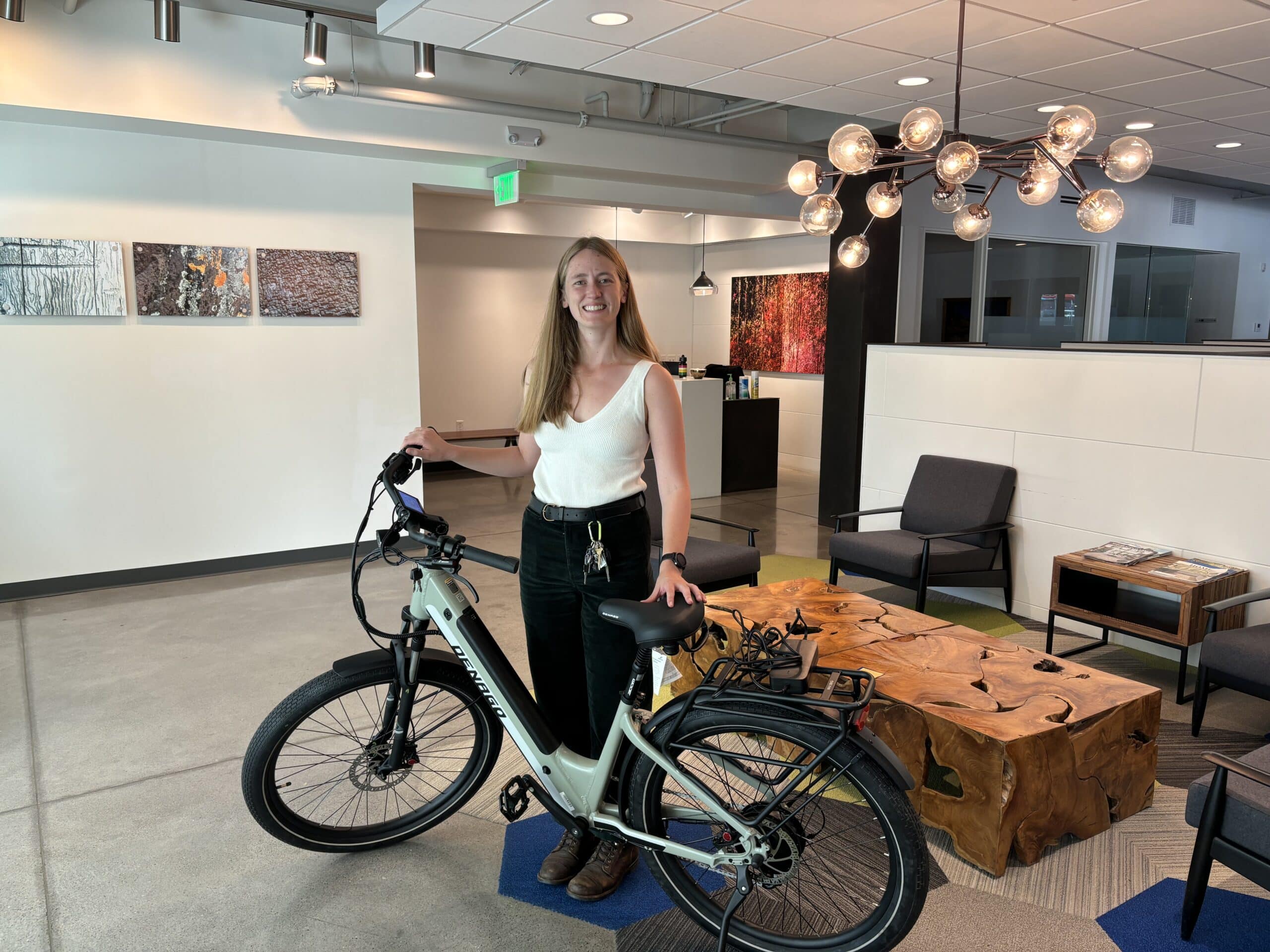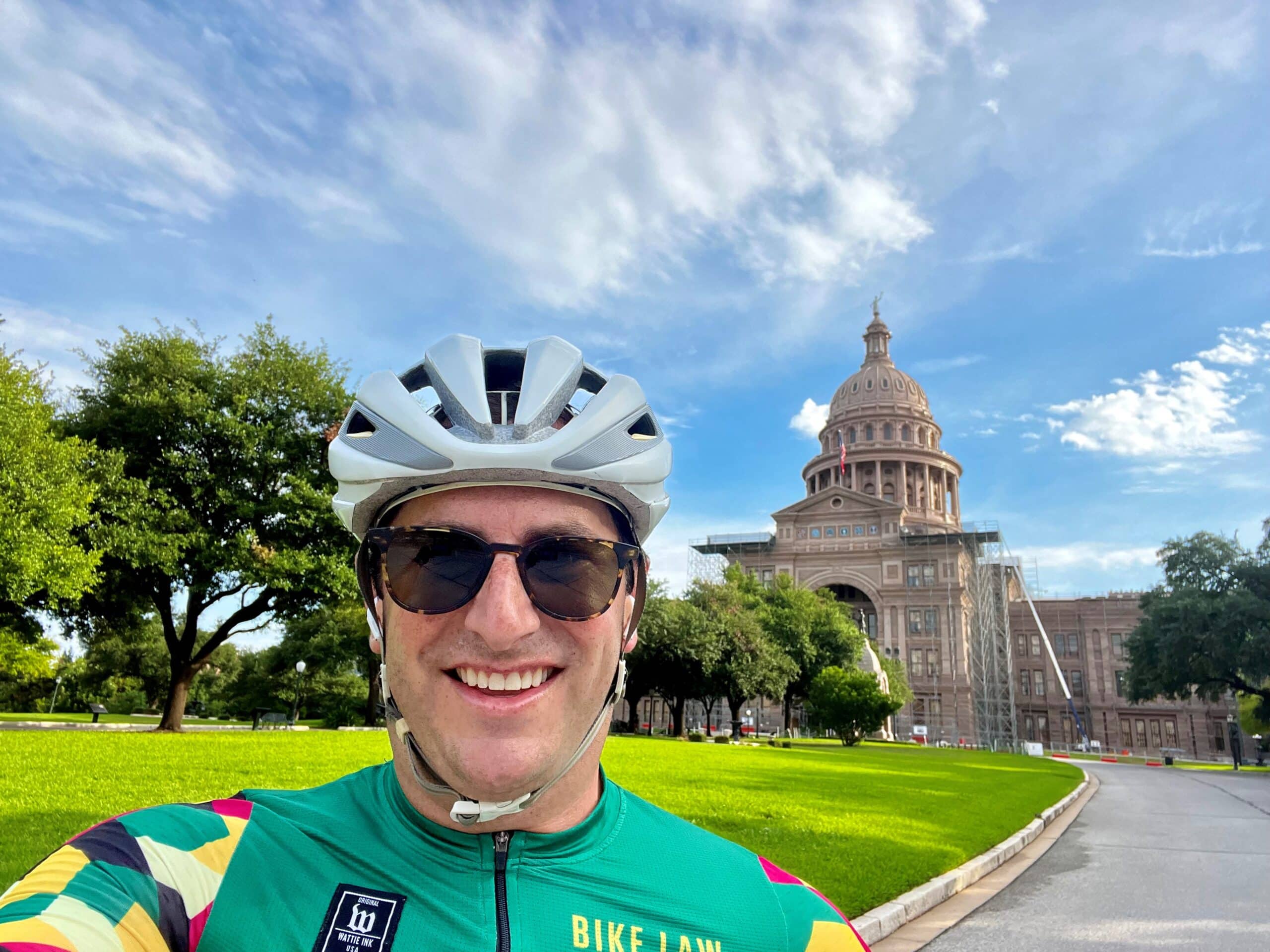On July 12, House Bill 959 was signed into law and it changes a few things for bicyclists. What effect, if any, will these changes have on bicycle safety?
A little background, if you haven’t been following along. Last summer, the Legislature passed HB 232 and set up a working group to study North Carolina bicycle laws. By the end of the year, the North Carolina Department of Transportation issued a report making a number of recommendations, some recommended by the bicycle safety working group, for changing our state’s bicycle laws. The new law includes three of the working group’s recommendations and an additional one they did not specifically address.
Let’s look at each one individually. The actual wording of each law is in italics.
BICYCLES MUST HAVE RED REAR LIGHT OR OPERATOR MUST WEAR REFLECTIVE VEST WHEN OPERATED AT NIGHT
G.S. 20-129(e) will read:
(e) Lamps on Bicycles. – Every bicycle shall be equipped with a reflex mirror on the rear and both of the following when operated at night on any public street, public vehicular area, or public greenway:
(1) A lighted lamp on the front thereof, visible under normal atmospheric conditions from a distance of at least 300 feet in front of such bicycle.
(2) A lamp on the rear, exhibiting a red light visible under like conditions from a distance of at least 300 feet to the rear of such bicycle or the operator must wear clothing or a vest that is bright and visible from a distance of at least 300 feet to the rear of the bicycle.”
SECTION 5.1.(b) This section becomes effective December 1, 2016, and applies to offenses committed on or after that date.
What it means: As of December 1, bicyclists riding in the dark are required to have both a front and rear light, both visible from 300 feet. It also provides an alternative (reflective clothing) as a possibly more affordable option. The new law retains some of the odd wording contained in the original statute. (Why not use the word reflector; what is a reflex mirror?) The language could also lead to confusion: is a reflector required when the bicyclist has an operating rear light on the bicycle? Such a requirement would make no sense, as the visibility of the light would supersede that of the reflector. The purpose of retaining the “reflector” language can only have been intended as a backup for when the light fails. For more on lighting, see here and here.
LIMITATIONS ON PRIVILEGE OF OVERTAKING AND PASSING
G.S. 20-150(e) reads as rewritten:
(e) The driver of a vehicle shall not overtake and pass another on any portion of the highway which is marked by signs, markers or markings placed by the Department of Transportation stating or clearly indicating that passing should not be attempted. The prohibition in this section shall not apply when the overtaking and passing is done in accordance with all of the following:
(1) The slower moving vehicle to be passed is a bicycle or a moped.
(2) The slower moving vehicle is proceeding in the same direction as the faster moving vehicle.
(3) The driver of the faster moving vehicle either (i) provides a minimum of four feet between the faster moving vehicle and the slower moving vehicle or (ii) completely enters the left lane of the highway.
(4) The operator of the slower moving vehicle is not (i) making a left turn or (ii) signaling in accordance with G.S. 20-154 that he or she intends to make a left turn.
(5) The driver of the faster moving vehicle complies with all other applicable requirements set forth in this section.
What it means: This new law does not allow a free-for-all for passing. Drivers are now allowed to pass bicyclists (and moped drivers) in no passing zones in the limited circumstances where: (1) there is enough sight distance to see that the way is clear, (2) the driver allows 4 feet of passing distance or moves completely into the other lane and (3) does not pass when the cyclist is making or is about to make a left turn.
Will making passing easier help make the roads safer for bicyclists? Most drivers already pass bicyclists in no passing zones; although it was technically illegal the restriction was rarely enforced. When done correctly, it promotes peaceful co-existence between drivers and bicyclists. When drivers pass bicyclists without enough distance between themselves and the bicyclists or without enough sight distance ahead, the maneuver is very dangerous. The new law provides important safety measures for a practice that most already follow.
Keep in mind that in other passing situations, the distance in North Carolina remains 2 feet.
SIGNALS ON STARTING, STOPPING OR TURNING
G.S. § 20-154 already required:
(a) The driver of any vehicle upon a highway or public vehicular area before starting, stopping or turning from a direct line shall first see that such movement can be made in safety, and if any pedestrian may be affected by such movement shall give a clearly audible signal by sounding the horn, and whenever the operation of any other vehicle may be affected by such movement, shall give a signal as required in this section, plainly visible to the driver of such other vehicle, of the intention to make such movement. The driver of a vehicle shall not back the same unless such movement can be made with safety and without interfering with other traffic.
The new law makes a couple of changes. The first is to increase punishments in certain motor vehicle – bicycle crashes.
(a1) A person who violates subsection (a) of this section and causes a motorcycle or bicycle operator to change travel lanes or leave that portion of any public street or highway designated as travel lanes shall be responsible for an infraction and shall be assessed a fine of not less than two hundred dollars ($200.00). A person who violates subsection (a) of this section that results in a crash causing property damage or personal injury to a motorcycle or bicycle operator or passenger shall be responsible for an infraction and shall be assessed a fine of not less than five hundred dollars ($500.00) unless subsection (a2) of this section applies.
(a2) A person who violates subsection (a) of this section and the violation results in a crash causing property damage in excess of five thousand dollars ($5,000) or a serious bodily injury as defined in G.S. 20-160.1(b) to a motorcycle or bicycle operator or passenger shall be responsible for an infraction and shall be assessed a fine of not less than seven hundred fifty dollars ($750.00). A violation of this subsection shall be treated as a failure to yield right-of-way to a motorcycle or bicycle, as applicable, for purposes of assessment of points under G.S. 20-16(c). In addition, the trial judge shall have the authority to order the license of any driver violating this subsection suspended for a period not to exceed 30 days. If a judge orders suspension of a person’s drivers license pursuant to this subsection, the judge may allow the licensee a limited driving privilege for a period not to exceed the period of suspension. The limited driving privilege shall be issued in the same manner and under the terms and conditions prescribed in G.S. 20-16.1(b)(1), (2), (3), (4), (5), and G.S. 20-16.1(g).
The second change is to clarify hand signals and to give bicyclists the option that most already use – extending the right arm to signal a right turn.
(b) The signal herein required shall be given by means of the hand and arm in the manner herein specified, or by any mechanical or electrical signal device approved by the Division, except that when a vehicle is so constructed or loaded as to prevent the hand and arm signal from being visible, both to the front and rear, the signal shall be given by a device of a type which has been approved by the Division.
Whenever Except as otherwise provided in subsection (b1) of this section, whenever the signal is given the driver shall indicate his intention to start, stop, or turn by extending the hand and arm from and beyond the left side of the vehicle as hereinafter set forth.
Left turn – hand and arm horizontal, forefinger pointing.
Right turn –upper arm horizontal, forearm and hand pointed upward.
Stop – upper arm horizontal, forearm and hand pointed downward.
(b1) Notwithstanding the requirement set forth in subsection (b) of this section that a driver signal a right turn by extending his or her hand and arm from beyond the left side of the vehicle, an operator of a bicycle may signal his or her intention to make a right turn by extending his or her hand and arm horizontally, with the forefinger pointing, from beyond the right side of the bicycle.
What it means: This section addresses movements other than passing. The changes to the section include (1) an increase in punishment when violation of the law causes injury to a bicyclist and (2) a clarification and slight change to hand signal requirements.
The increased punishments for violation of this section already applied in cases where property damage or injury of a motorcyclist resulted. It now extends those punishments to crashes involving bicyclists.
Will the new punishments make a difference? Only time will tell. They are hardly severe: from a $200 fine for a violation causing the bicyclist to change lanes or leave the road to a $750 fine for violations causing significant property damage or serious personal injury. In the event of the latter, a judge may also suspend the driver’s license for 30 days. It is unlikely these punishments will act as a general deterrent. I take some hope in the possibility that they will send a message and are a step in the right direction.
The hand signal change is helpful. Most bicyclists instinctively use the outstretched right arm to signal a right hand turn (instead of the left arm out with hand pointed up). The new law now makes it official. For drivers and bicyclists making an effort to get along, communication is one of the most important safety components and this law adds a common sense component to those communications.
With the passage of HB 232 last year and HB 959 this month, the North Carolina Legislature has indicated a strong interest in bicycle – motor vehicle interaction. HB 959 contained the mostly noncontroversial components of the working group’s recommendations. Stayed tuned for the Legislature to address other, more controversial issues in upcoming sessions.
To find out about your candidates’ positions on issues important to bicyclists, please visit www.vote4bikes.org.

North Carolina lawyer and Bike Law founder, Ann Groninger, has advocated at the state level on behalf of bicyclists in North Carolina for over 15 years. Ann has offices in Charlotte and Durham and has helped bike accident clients in Asheville, Raleigh, Durham, Greenville, Wilmington, Fayetteville, and throughout the state. Read more about Ann on her bio page.








